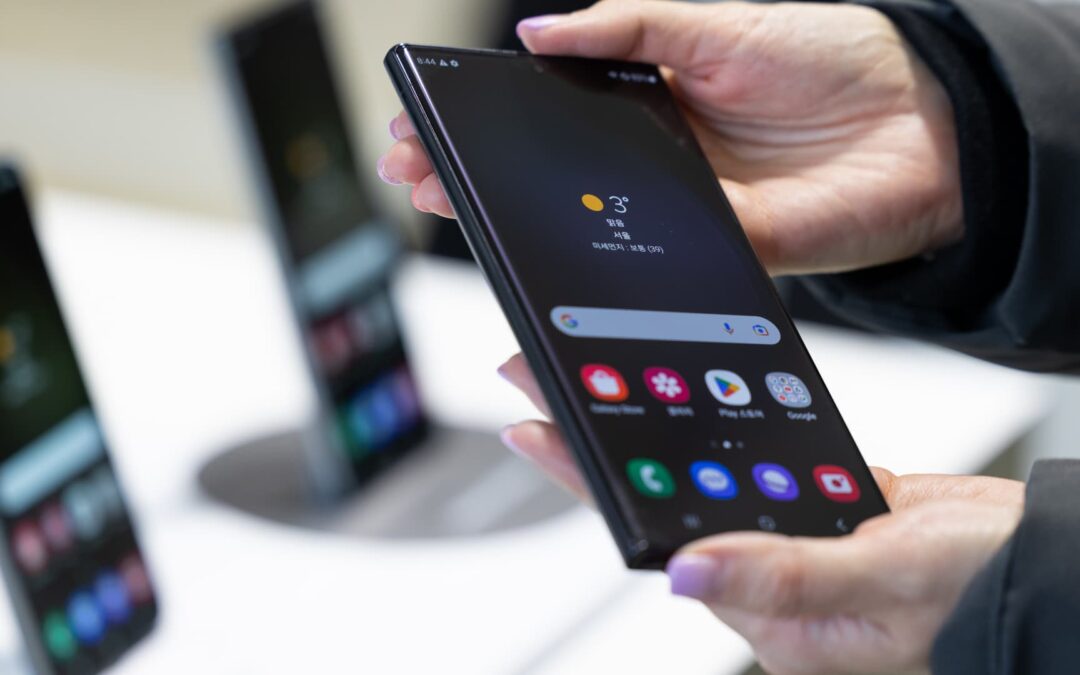A Samsung Galaxy S23 Ultra smartphone.
SeongJoon Cho | Bloomberg via Getty Images
Smartphones with displays capable of repairing themselves could start appearing on the market by 2028, according to analyst firm CCS Insight.
In its roundup of top tech predictions for 2024 and beyond, CCS Insight said that it expects smartphone makers to begin producing phones with “self-healing” displays within five years. The way this could work is by incorporating a “nano coating” on the surface of the display that, if scratched, creates a new material that reacts when exposed to air and fills in the imperfection.
“This is not in the realms of science fiction, it can be done,” Wood told CNBC on a call earlier this week. “I think the biggest challenge with this is setting expectations correctly.”
Companies have been talking about smartphone display technology that can be self-repaired for several years now.
LG, the South Korean consumer electronics giant, was touting self-healing technology in its smartphones as far back as 2013. The company released a smartphone called the G Flex which featured a vertically curved screen and a “self-healing” coating on the back cover. It didn’t explain how exactly the technology worked at the time.
“There’s some new technologies that people are working on right now that looks as though this could become something that people have another go with. We’re not talking about smashed screens miraculously coming back. This is all just little cosmetic scratches,” Wood told CNBC.
A few other phone makers have touted self-healing materials in smartphones. In 2017, Motorola filed a patent for a screen made from a “shape memory polymer” which, when cracked, repairs itself. The idea is that, when heat is applied to the material, it heals over the cracks.
Meanwhile, Apple also previously secured a patent for a folding iPhone with a display cover that would fix itself when damaged.
Still, the technology is yet to be found in a commercially successful handset. And there are a few barriers to launching such phones at a mass scale.
For one, companies require lots of investment in research and development to ensure they can identify new innovations in smartphone screens. Cash is also required to market and sell the phones in big volumes — and ensure consumers are actually properly informed about what level of damage in the phones can be fixed without any manual intervention.
Wood jokingly said he fears that tech tear-down enthusiasts like the popular YouTuber JerryRigsEverything will take a knife to test their self-healing capabilities. This, he says, isn’t the point of self-healing devices. Rather, it’s about technology that can make minimal repairs to the surface of its own accord.
Phone makers are getting more and more inventive when it comes to display technology. At the Mobile World Congress in Barcelona, Motorola released a rollable concept smartphone that extends vertically when pushed upward.
Samsung is pretty far along in the journey toward commercial smartphones with more advanced displays, with its folding Galaxy Z Fold 5 and Z Flip 5 phones now capable of folding hundreds of thousands of times over their lifetime.
HTC could exit VR market by 2026
Separately, CCS Insight also predicted that Taiwanese tech giant HTC will bow out of the virtual reality industry by 2026.
HTC was a pioneer in the smartphone market, responsible for several models which broke the mould in terms of design, performance and functionality. The company’s HTC Hero, HTC Legend, HTC Desire and HTC One were among some of the leading Android phones.
But in 2017, HTC more or less exited the smartphone market and sold its handset business to Google, which has since gone on to aggressively expand its drive into consumer hardware with its Pixel range of devices and Nest smart home products.
HTC has largely staked its future on the merging of virtual and physical worlds. In January, the company launched its Vive XR Elite device, a lightweight headset focused on gaming, fitness and productivity, at a $1,099 price point.
CCS Insight thinks that the firm will quit the VR space due to dwindling revenues and growing competition from Meta, Sony, and, more recently, Apple.
“HTC was one of the pioneers of VR, they’ve done a lot there,” CCS Insight’s Wood said. “But they have kind of struggled to compete, because they haven’t gone for the race to the bottom on price, whereas Meta, with Quest, have been prepared to take very aggressive pricing — almost just above cost pricing — to drive adoption.”
HTC “may get a little bit of an uptick with Apple coming into the space as it’s kind of renewed interest in the category,” Wood continued. “But, ultimately, we think it’s hard for them to stay in it. So we’re predicting that by 2026, they’ll exit the market, and they’ll sell their IP [intellectual property] to some of the other players who are bigger in the space.”
Apple takes control of second-hand market
CCS Insight also predicted that Apple will seek to gain more direct control over the second-hand smartphone market to avoid the growing popularity of second-hand devices denting sales of new iPhones.
Apple may do this by encouraging customers to trade in their phones with the company directly, rather than relying on third-party marketplaces like PCS Wireless; or by incentivizing carriers to give in their old phones to get credits to offset the cost of buying a new iPhone, the firm’s analysts said.
Apple could also start focusing on a “verified” system for grading refurbished iPhones, in order to encourage quality secondhand devices, according to CCS Insight — reinforcing the move in the technology industry toward more “circular” products that can be repaired and resold to avoid electronic waste.
CCS Insight estimates iPhone accounts for around 80% of the organized secondary smartphone market.







